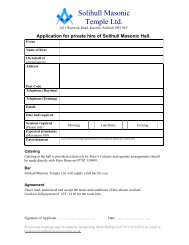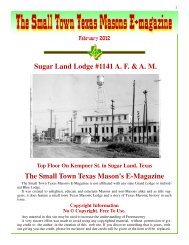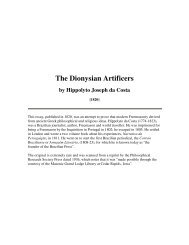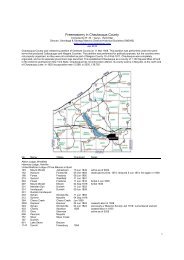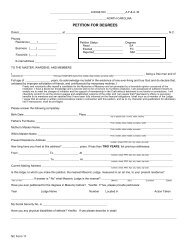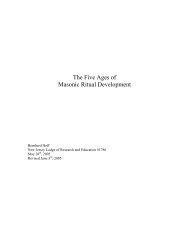Entered apprentice info - MasterMason.com
Entered apprentice info - MasterMason.com
Entered apprentice info - MasterMason.com
You also want an ePaper? Increase the reach of your titles
YUMPU automatically turns print PDFs into web optimized ePapers that Google loves.
placed upon the catechumen who had been newly baptized, to denote that he had been cleansed from his former sins,<br />
and was henceforth to lead a life of purity. Hence, it was presented to him with this solemn charge:<br />
"Receive the white and undefiled garment, and produce it unspotted before the tribunal of our Lord, Jesus Christ,that you<br />
may obtain eternal life. "<br />
"From these instances we learn that white apparel was anciently used as an emblem of purity, and for this reason the<br />
color has been preserved in the apron of the Freemason.<br />
"A Freemason’s apron must be made of Lambskin. No other substance, such as linen, silk or satin could be substituted<br />
without entirely destroying the emblematical character of the apron, for the material of the Freemason’s apron constitutes<br />
one of the most important symbols of his profession. The lamb has always been considered as an appropriate emblem of<br />
innocence. Hence, we are taught, in the ritual of the First Degree, that "by the lambskin, the Mason is reminded of the<br />
purity of life and rectitude of conduct which is so essentially necessary to his gaining admission into the Celestial Lodge<br />
above, where the Supreme Architect of the Universe forever presides. "<br />
Words grow and change in meaning with the years; a familiar example is the word "profane " which Masons use in its<br />
ancient sense, meaning "one not initiated " or "one outside the Temple. " In <strong>com</strong>mon usage, profane means<br />
blasphemous. So has the word "innocence " changed in meaning. Originally it connoted "to do no hurt. " Now it means<br />
lack of knowledge of evil - as an innocent child; the presence of virginity - as an innocent girl; also, the state of being free<br />
from guilt of any act contrary to law, human or Divine.<br />
"An Emblem of Innocence " is not, Masonically, "an emblem of ignorance. " Rather do we use the original meaning of the<br />
word, and make of the apron an emblem of one who does no injury to others. This symbolism is carried out both by the<br />
color and material; white has always been the color of purity, and the lamb has always been a symbol of harmlessness<br />
and gentleness. Haywood says:<br />
"The innocence of a Mason is his gentleness, chivalrous determination to do no moral evil to any person, man or woman,<br />
or babe; his patient forbearance of the crudeness and ignorance of men, his charitable forgiveness of his brethren when<br />
they willfully or unconsciously do him evil; his dedication to a spiritual knighthood in behalf of the value and virtues of<br />
humanity by which alone man rises above the brutes and the world is carried forward on the upward way. "<br />
The lambskin apron presented to the initiate during his entered Apprentice Degree should be for all his life a very precious<br />
possession; the outward and visible symbol of an inward and spiritual tie. Many, perhaps most, Masons leave their<br />
original aprons safely at home, and wear the cotton drill substitutes provided by many lodges for their members. But here<br />
again the outward and evident drill apron is but the symbol of the presentation lambskin symbol; the symbol kept safely<br />
against the day when, at long last, the members of a lodge can do no more for their brother but lay him away under its<br />
protecting and <strong>com</strong>forting folds.<br />
Truly he has been a real Mason, in the best sense of that great word, who has worn his lambskin apron during his<br />
manhood "with pleasure to himself, and honor to the Fraternity. "<br />
Within the Master’s reach in every Lodge is some table, stand, pedestal or other structure on which he may lay his<br />
papers. Often this is considered the trestle-board because upon it the Master draws the design for the meeting. Any<br />
brother has a right to read into any symbol his own interpretation; for those to whom this conception is sufficient, it is good<br />
enough. But it seems rather a reduction of the great level of the little. A light house is, indeed, a house with a light, but he<br />
who sees but the house and the light, but fails to visualize those lost ones who by it find their way; who cannot see the<br />
ships kept in safety by its ceaseless admonition that this way lies danger; who cannot behold it as a symbol as well as a<br />
structure, misses its beauty. Those who see only the pedestal which supports the Master’s plans as a Speculative Trestleboard<br />
miss the higher meaning of the symbol.<br />
Lodge notices are not infrequently called trestle-boards, since on them the Master draws the design for the <strong>com</strong>ing work,<br />
and sends them out to the Craftsmen. This too, seems belittling of the symbol, unless the brethren are led to see that so<br />
denominating the monthly notice is but a play on words, and not a teaching.<br />
A Freemason’s trestle-board, his own <strong>com</strong>bination of what he may learn from man and nature, from the Book of<br />
Revelation on the Altar, and the designs in his own heart, is a great and pregnant symbol. It is worthy of many hours of<br />
pondering; a Masonic teaching to be loved and lived. Who makes of it less misses something that is beautiful in<br />
Freemasonry.<br />
===========================================================================================<br />
47



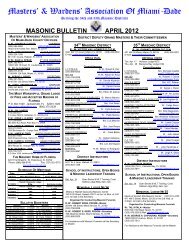
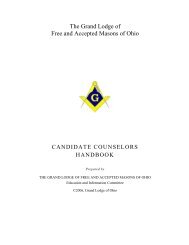
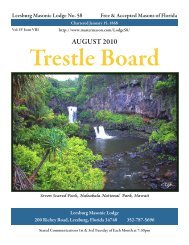

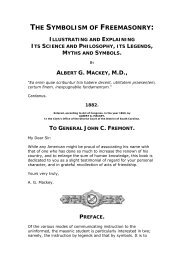

![Junior Grand Warden Views [2005-2] - MasterMason.com](https://img.yumpu.com/36303049/1/190x245/junior-grand-warden-views-2005-2-mastermasoncom.jpg?quality=85)
